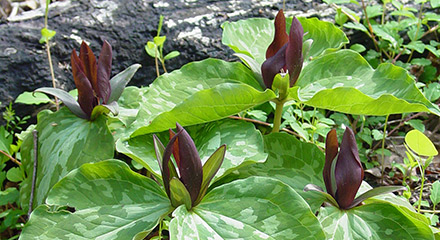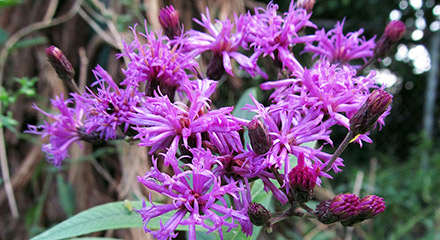By Kristin Love
Throughout the 1,440 acres of Chicopee Woods, Elachee has identified over 70 different species of wildflowers who take root in our soils. So what is a wildflower and how is it different from the cultivated gardens found in our backyards? Per the Oxford Dictionary, a wildflower is a flower of an uncultivated variety or a flower growing freely without human intervention. This makes wildflowers the bread and butter of a nature preserve like Chicopee Woods, with the goal of preserving the land for our native flora and fauna to flourish.
Some of the most breathtaking specimens grace the sides along our 12.24 miles of hiking trails, allowing our visitors the opportunity to view these incredible wildflowers up close. Check out some of the favorite wildflower picks chosen by Elachee staff!

Common Name: Toadshade Trillium, Red Trillium, Sessile Trillium, Toad Trillium, Wood Lily
Scientific Name: Trillium sessile
Claim to Fame: Trilliums are special to Georgia because our state is host to at least 22 species, more than any other state in the US.
Found in: Eastern US

Common Names: Fire Pink, Scarlet Catchfly
Scientific Name: Silene virginicia
Claim to Fame: The genus name, Silene, is derived from “catchfly” or “campion.” The plants in this genus have sticky hairs that discourage ants and other insects from eating the plant. This allows for hummingbirds and butterflies to exclusively access this wildflower’s nectar.
Found in: Central US to the East Coast, but considered endangered in Florida, Michigan and Wisconsin

Common Names: Giant Ironweed, Tall Ironweed
Scientific Name: Veronia gigantea
Claim to Fame: While this perennial is a favorite of monarchs, small mammals and livestock tend to avoid grazing on this wildflower due to its bitter taste.
Found in: Southeastern US
Photo Credit: cbaile19

Common Names: Trout Lily, Adder’s Tongue, Dog’s Tooth Violet
Scientific Name: Erythronium americanum
Claim to Fame: While most wildflowers depend on wind or birds to disperse their seeds, the Trout Lily depends on the lowly ant. The Lily’s seed has a coating that ants find irresistible. The ants will carry off the seeds, take them underground, devour the seed coating, and leave the rest of the seed to sprout!
Found in: Eastern US
Photo Credit: Schuylkill Center
Would you like to learn more about native flora found in the state of Georgia? Check out the wildflower-focused opportunities at Elachee this month! https://www.elachee.org/events
March 18, 2023: Discovery Saturday, where visitors can join the guided wildflower hike as part of Saturday Explorations at Elachee in addition to enjoying other self-guided attractions at the Nature Center.
Want to see all the known species of wildflowers found in Chicopee Woods? Check out the comprehensive list here! https://bit.ly/3ROhlvd
